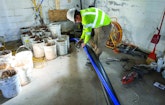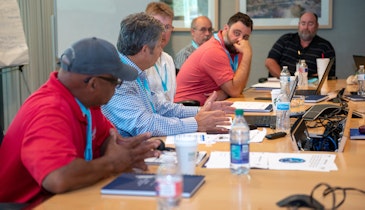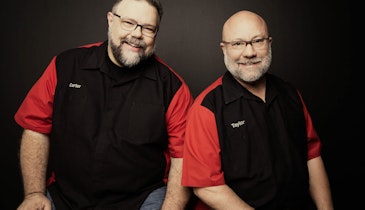
Scott Lamers Construction technician Rene Cortes uses a HammerHead PB30 to pull a cable that will be used to pull a new water and sewer line into a home. The company added pipe bursting to its service offerings 15 years ago and continues to see it grow.
Interested in Bursting?
Get Bursting articles, news and videos right in your inbox! Sign up now.
Bursting + Get AlertsScott Lamers has worked in construction since he left high school in 1986. Fifteen years ago, after two decades in the industry in and around his hometown of Kaukauna, Wisconsin, Lamers looked at the work he was doing and realized he needed to reposition his company if he wanted it to continue to be successful. He got into the trenchless pipe repair business.
“I sat down and looked at what I was doing,” Lamers recalls of that pivotal moment. “I was working steadily, but it was hard to get work and to be competitive.” He peered into the future and saw that sewer work in general and inflow and infiltration issues in particular would be a focus of contractual work.
Subsequent conversations with local municipal engineers confirmed his view. “So, I decided to spend some more money and get into the specialty work,” he says. He bought his first pipe bursting machine in 2008 and quickly began scaling up the work.
Today, Scott Lamers Construction is the premier pipe bursting contractor in the Fox Valley and is still growing in the East Central Wisconsin market.
ENTERING THE INDUSTRY
While the move was a prescient business decision, a willingness to change was not out of character for Lamers. The 55-year-old contractor grew up on a dairy farm but left the agrarian life behind at age 18 to become a mason tender, or helper, carrying brick and mixing mud. In time, he moved along to do concrete flatwork for a contractor.
He then left that to get into excavation work and, for the following nine years, moved a lot of Wisconsin soil for a contractor operating backhoes and dozers, push-loading scrapers and excavators. Most of the dirt-moving was commercial site work.
At that point, Lamers once again found himself wondering about his future.
“I remember one night lying awake at night thinking about all the stuff I was going to be doing for the company that I was working for and saying to myself, ‘If this is what I’m going to be doing, I might as well be doing it for myself.’”
Such entrepreneurial instincts aren’t found in every working man or woman, but Lamers was the oldest son of a dairyman, so he was acquainted with what it meant to be self-employed. His two younger brothers today also work for themselves. Wanting to be one’s own boss runs in the family.
Scott Lamers Construction came into being at that point, but it didn’t burst upon the Kaukauna construction contracting market in a big way. Lamers had no equipment and one employee. What he did have was a contract for snow removal in a region that receives 30-40 inches of snow in winter months. He bought a backhoe and went to work.
Today, the company still offers a snow removal service and traditional excavation and earthmoving work. Its equipment yard is filled with machinery capable of performing such work — four hydraulic excavators ranging in size from a 15-ton Caterpillar to a Volvo mini model, as well as a pair of full-size wheel loaders and three skid-steers.
More to the point, in the yard are three HammerHead PB30 portable pipe bursting units, each with 30-ton pulling force. On a good day, each of his crews uses the equipment to burst two or three faulty lines on job sites and pull in replacement lines, most of the pipe being in the 4-inch to 6-inch range.
Why HammerHead? It’s an established brand, of course, but Lamers also was drawn to the manufacturer because it’s a Wisconsin company. “I try to stay local. That’s important to me,” he says. The company caught his attention also because it was instrumental in getting pipe bursting accepted in the area plumbing code.
Since going with HammerHead, Lamers Construction has developed something of a professional relationship with the manufacturer. This past summer, for example, the company tried out some new tools using Lamers’ crews “to give the products some real-world trial-and-error testing.”
Also found in Lamers’ work trucks are RIDGID SeeSnake inspection cameras. However, they are infrequently used, according to Lamers, because 80% of the company’s work is on municipal projects. “They do their own camera work. They already have inspection reports.” Nevertheless, each pipe bursting crew has a camera and knows how to operate it to find intersecting lines and otherwise peer in pipes.
BECOMING A STANDARD
Seventy percent of the company’s business is pipe bursting, which is more than adequate proof that Lamers was right to concentrate on trenchless repair work 15 years ago. The excavators and wheel loaders still get workouts on commercial site developments, though, and produce some 20% of company revenue. The balance of income is from snow removal work.
A new service that has just begun to be offered, directional drilling, is a consequence of a change of ownership. Lamers was approached by another local businessman — who is a dairy farmer among other enterprises. He subsequently sold the business to Seven Oaks HD earlier this year. Now, Lamers is formally general manager of the company he founded and is chomping to get out of the office and back to bursting and digging.
“I very much prefer being in the field to being in the office,” he says. “I’ve expressed to the new owner that he find someone to take over my desk. It’s not where I like to be.”
The change at the top will have no impact on the business besides enhancing its lineup of services. “We want to be a one-call company and make it easy for everybody,” Lamers says. “Whether it’s bursting or directional drilling or opencut, we want to be the company they call and to do all the work in-house.”
As he has for 15 years, the now-general manager will still be pushing the company’s mainstay product — a trenchless solution. Lamers first promoted pipe bursting by leaning on municipal engineers until they began to include it in their bids. Then he went to local sewer cleaning companies and persuaded many of them to refer pipe repair jobs to him in return for a finder’s fee.
The upshot is that, in the Fox Valley, trenchless repair has become the standard for repairing a faulty pipe, according to Lamers. Most of the trenchless work is by bursting a pipe, with pipelining a distant second choice. “Opencut is a last resort.”
When Lamers entered the local market, one other trenchless outfit was in business. That company’s market share has since faded and a new competitor has come on the scene, but Lamers Construction remains the principal pipe bursting contractor in Fox Valley.
GROWING WORK
The bursting activity is a year-round work, according to Lamers, though not as much as he would like. The Valley is not so far north that frozen ground can’t be penetrated in winter months and the business owner is trying to get local engineers to schedule more work then.
Because pipe bursting requires minimal surface excavation, frozen soil is not an issue. A Lamers crew places an electric blanket on the ground where the crew wants to excavate an entry hole and within three or four days, the ground is diggable. Actual bursting is below the frost line. “Things slow down in the winter, but we try not to lay off guys. I’m pushing hard for municipalities to schedule some of these jobs from December through March.”
Regardless of the season, Scott Lamers Construction LLC is all about doing a job right. Lamers says his goal all along has been to attract customers through quality of work rather than the cost of it. “My thing always has been, I don’t want to get calls from customers because we are the cheapest,” he says. “I want them to call because they know we will come out and get the job done.”











